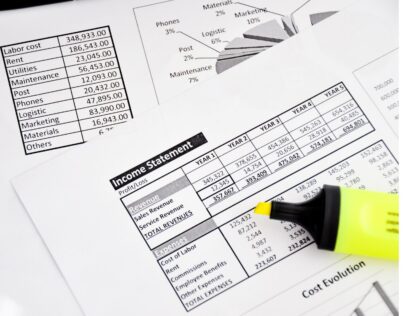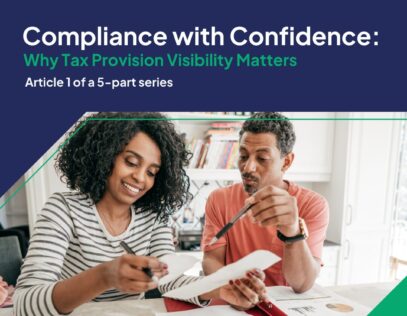The world of accounting is governed by rules, plusses and minuses, black and white. But the world of business is full of unknowns and unknowables—shifting expectations, conditions, regulations, and other gray areas which must nonetheless be accounted for in the financial statements. That requires making estimates about what the future may hold.
That’s where the valuation allowance (VA) comes in. While not exactly an accounting household word, the VA can in fact play a critical role in representing a company’s financial position. As a potential component of the tax provision process, it directly impacts the company’s total expense, earnings, and effective tax rate (ETR)—the picture it paints for the world about its financial health.
Because the VA involves judgment calls and complex calculations, it will be scrutinized by every pair of eyes downstream—from the tax department to auditors to tax authorities. That makes it a crucial concept to understand. In this article, we dive in and take a closer look.
How, where, and why the valuation allowance comes into play
Let’s start by putting the valuation allowance into the context of the company’s deferred tax roll forward calculation (aka, “deferreds”), the trickiest part of the tax provision process.
That process begins with the current provision: an estimate of the company’s income tax liability that will figure on its current-year tax return. To get there, the tax department must reconcile booked income with taxable income—making adjustments to the former and adding net operating losses and tax credits to the latter. These adjustments will either be permanent (booked items like meals that will never be tax-deductible) or temporary (booked items like accruals that aren’t yet includable as income or deduction).
It’s those temporary book-to-tax differences—timing differences in the treatment of an income or expense item between accounting and tax that will reverse in the future—that are of interest here. That’s because they give rise to deferred tax assets (DTAs) and liabilities (DTLs), which appear on the company’s balance sheet. Deferreds reflect the impact of items on future tax returns, be they future benefits (e.g., a deduction or credit), or future expenses (e.g., a future income item), respectively.
For companies like startups, the potential benefit of DTAs is obvious: they’re essentially treated as an advance payment of taxes that can be carried forward indefinitely to offset future taxable income, while positioning the company in the best possible light today. But what if a company consistently operates at a loss, with little credible prospect of future taxable income?
Enter the valuation allowance. Under ASC 740 (the U.S. Financial Accounting Standards Board’s rules for how companies should account for income taxes in their financial statements), if there is reasonable doubt as to whether there will be adequate taxable income in future years to offset that deferred tax asset, the company must set up a reserve to cover some portion of the potential losses from the DTA.
That reserve—the valuation allowance—serves as a check on a company’s natural incentive to overstate assets and understate liabilities. It’s there to ensure that the amount of deferred tax assets on the balance sheet is accurately and appropriately represented.
But how do you figure out what that reserve should be—or if you will even need one? Not an easy task if you don’t have a crystal ball. Fortunately, there’s a method to the madness.
Do you need a valuation allowance?
The question of whether a company must use a valuation assessment is a crucial one: if so, it will negatively impact the deferred tax benefit—resulting in a higher total tax expense, lower earnings, and higher ETR.
So how do you thread that needle? Under U.S. GAAP, the determination is generally based on an estimation that there is a greater than 50-50 chance that some or all of that deferred tax asset will not be realized due to insufficient future taxable income. That standard is called “more likely than not,” or MLTN—and it is conducted on a jurisdictional basis.
To undertake the analysis, the company must assess a plethora of factors, both positive and negative. They’ll need to examine their income sources thoroughly—analyzing past and projected financial performance, tax planning strategies, carryback years, and the potential reversal of favorable temporary differences. Positive evidence, such as strong earnings history and sales backlog, would support the realization of deferred tax assets. Negative evidence—past and projected losses, unfavorable business trends, uncertainties in earnings forecasting—might necessitate a VA.
Given the complexity of this analysis and the subjectivity in making those judgment calls (not to mention, the potential negative impact on earnings and ETR), companies have plenty of reason to want to avoid using valuation allowances. But precisely because of that subjectivity, deferreds and their supporting journal entries are closely scrutinized by financial statement auditors and tax authorities. And in fact, if you are already subject to a valuation allowance, you might be eager to conduct this analysis—and enjoy a boost in profitability if the MLTN test supports reducing or even eliminating it.
Valuation allowances are not rare
Valuation allowances are commonly seen in loss companies, including startups and ones significantly impacted by large-scale adverse events (as we saw during the COVID-19 pandemic). Such companies generate deferred tax assets from net operating loss carryforwards and tax credit carryforwards but struggle to utilize them due to a lack of taxable income. But even profitable enterprises may need them in certain jurisdictions where they consistently operate at a loss.
The VA analysis must be continually reassessed—on a quarterly basis in the U.S., annually for foreign companies—to ensure it doesn’t need to be increased or decreased. This continuous evaluation ensures that changes in financial performance and business conditions, positive or negative, are adequately reflected in the valuation allowance. Should any changes need to be made, a journal entry must be added to make the necessary adjustments.
Valuation allowance is a balancing act—but it needn’t be a high-wire act
The deferred rollforward holds crucial importance in the tax provision process, as it requires meticulous examination and documentation of balances. By ensuring that deferred tax assets are appropriately stated, the valuation allowance plays a key role in ensuring the accuracy of a company’s financial statements.
Determining whether one is needed requires examining a delicate interplay of positive and negative evidence—and making a sober, credible, and transparent assessment from that evidence. It can be a real balancing act for companies, but it’s not a life-or-death process, because the VA is based on judgment—and the rules for making the assessment are more guidelines than guardrails.
One thing is for sure, though: The result of that assessment can have a profound impact on the company’s financial health and effective tax rate—not to mention, whether or not you get a clean audit.







